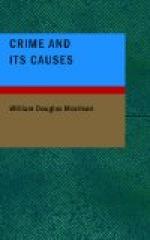In the preparation of this volume I have carefully examined the most recent ideas of English and Continental writers (especially the Italians) on the subject of crime. The opinions it contains are based on an experience of fourteen years in Orders most of which have been spent in prison work. In revising the proofs I have received valuable assistance from Mr. J. Morrison.
W.D.M.
CRIME AND ITS CAUSES
CHAPTER I.
The statistics of crime.
It is only within the present century, and in some countries it is only within the present generation, that the possibility has arisen of conducting the study of criminal problems on anything approaching an exact and scientific basis. Before the introduction of a system of criminal statistics—a step taken by most peoples within the memory of men still living—it was impossible for civilised communities to ascertain with absolute accuracy whether crime was increasing or decreasing, or what transformation it was passing through in consequence of the social, political, and economic changes constantly taking place in all highly organised societies. It was also equally impossible to appreciate the effect of punishment for good or evil on the criminal population. Justice had little or no data to go upon; prisoners were sentenced in batches to the gallows, to transportation, to the hulks, or to the county gaol, but no inquiry was made as to the result of these punishments on the criminal classes or on the progress of crime. It was deemed sufficient to catch and punish the offender; the more offences seemed to increase—there was no sure method of knowing whether they did increase or not—the more severe the punishment became. Justice worked in the dark, and was surrounded by the terrors of darkness. What followed is easy to imagine; the criminal law of England reached a pitch of unparalleled barbarity, and within living memory laws were on the statute book by which a man might be hanged for stealing property above the value of a shilling.
Had a fairly accurate system of criminal statistics existed, it is very likely that the data contained in them would have reassured the nation and tempered the severity of the law.




